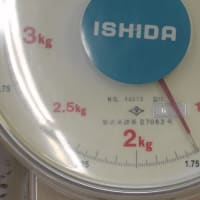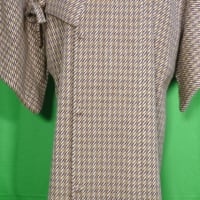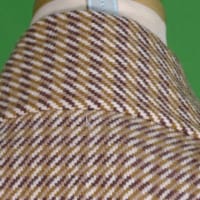Women's unlined kimono with a sushi cat pattern.すしねこ柄の単衣の着物
最近販売されている和服の中にはプリント(印刷)で柄を染めた生地で作られた着物や羽織、長襦袢があります。
ただ着物地は着物一枚分の長さで売られていて、裄や袖幅は反物幅によっては裄が長くなり袖幅が広くなると寸法通りに出来ない事があります。
そこで着物地に限定しないでグーグルで綿プリント柄布地とか、綿麻プリント柄布地で検索するとその多くは洋服地になりますが楽天などで和柄も含めた多種多様な布地がヒットします。
洋服地の良い処は縫い上げる着物に必要な長さを切り売りで買える事で、布幅は着物地の広幅でも41cm程度ですが洋服地は110cmから145cm位と数種類あり、いずれにしても裄が長く袖幅が広くても寸法通りに出来ないという心配はありません。
また柄の配置でも裁断する長さと幅とも調整する事が出来るので、着物地よりも高度な柄の裁ち合せが出来ると思います。
苦手な裁断の要尺の計算はエクセルの裁断図に任せて、今回のねこすし柄の綿85%、麻15%の綿麻の布地は幅が110cmあり要尺計算をしてとりあえず長さを500cmほど買いました。
注意したとろは裁切袖幅と身頃幅でそれぞれ最適だと思う縫代を考えて裁切幅を決めました。
仕立てたのは女物の単衣の着物(長着)ですが、洗濯機洗いの布地の縮みを考慮し水通しをして、更に身丈を2cm、袖丈を8mm長くしました。
普通の着物は背縫いが付いて、ほとんどの単衣の着物は背縫いの補強の為に居敷当を付けますが、今回の布地は布幅が広いので背縫いを無くし居敷当も付けませんでした。
ただ着付けの際に背縫いが無いと背中心が分からず着にくいと言う意見も有ったので、背中心の目印に運針で縫い目を付けて畳むときにそこに折り目を付けました。
また洋服地のプリント柄の裏側が染まっていない布地が多いので、着用した時にめくれて裏側が見えやすい袖口には袖口布を、袖の振り側は三つ折りぐけの出来上がりを4.5cm程度に、裾の三つ折りぐけの出来上がり幅は11cmにしてそこまで表地が見える様にしました。
まためくれて裏側が見えやすい上前の衽にも裏側に比翼の様に表地をはめこみました。
衿については今回の生地はやや厚く広衿で折り畳むと分厚すぎるのでばち衿にして、共衿かけの横の縫い目のくけ側は縫わずに開けて、そこから衿芯を差し込める様にしました。
身丈直しは内揚は有りませんが裾ぐけ分が15cm程度あるので数センチ程度の身丈の調節は裾の三つ折りぐけだけで出来ます。
私は女物の着物の基本型の鉄壁な着姿に必要なアイテムのはおはしょりと半衿、浴衣的な着姿でもおはしょりは鉄壁で半衿の代わりに洋服を合せる着こなしが進化するのではと思っています。
なので基本形の着姿でも浴衣的な着姿の進化系に対応した着物を作ろうと思い、ねこすし柄以外にもふくろうのアイス柄や、ウイリアムモリスのいちご泥棒柄、鳥獣戯画柄の布地も買い込みいずれの布地も綿や麻、綿麻等の礼装には絶対ならない素材なので、遊び心とお洒落心と着心地を大切にして着物や羽織や長襦袢の制作と販売をしていこうと思っています。
洋服地から作る着物は岩佐和裁のショッピングページで販売しています。
Kimonos, haori, and nagusa undergarments made from fabrics with dyed prints are among the kimonos on the market these days.
However, kimono fabrics are sold in the length of one kimono, and depending on the width of the fabric, the length of the sleeves and the width of the sleeves may not be the same as the measurements if the sleeves are long and the sleeves are wide.
Therefore, if you search for cotton print pattern fabric or cotton linen print pattern fabric on Google without limiting to kimono fabric, most of them will be Western-style fabrics, but a wide variety of fabrics including Japanese patterns will be hit on Rakuten.
The good thing about the kimono fabric is that you can buy it by the length you need for the kimono to be sewn. Even if the sleeves are long and wide, you don't have to worry about not being able to make them according to the measurements.
In addition, the length and width of the pattern can be adjusted, so I think that it is possible to cut the pattern more advancedly than the kimono material.
I'm not good at calculating the necessary length for cutting, but I left it to the cutting diagram in Excel. I bought about 500 cm.
I decided on the cutting width considering the seam allowance that I think is best for the width of the sleeve and the width of the body.
I made a women's unlined kimono (nagagi), but I made it 2 cm longer and 8 mm longer sleeves, taking into consideration the shrinkage of the fabric when washing in a washing machine.
Ordinary kimonos have a back seam, and most unlined kimonos have a back seam to reinforce the back seam.
However, there was an opinion that it would be difficult to put on if there was no seam on the back, so I sewed a seam on the center of the back and made a crease when folding.
In addition, there are many fabrics that are not dyed on the back side of the printed pattern of the clothes, so cuff fabric is used for the cuffs where it is easy to see the back side when worn. I set the finished width of the three folds to 11 cm so that the outer material can be seen to that extent.
In addition, the outer side of the front hem is turned up and the back side is easy to see, and the outer side is inlaid on the back side like a hiyoku.
As for the collar, the fabric this time is a little thick, so it's too thick when folded with a wide collar, so I used a bachi collar and left the side seams of the joint collar hanging open without sewing, so that the core of the collar can be inserted from there. did.
There is no inner lift to adjust the length, but since there is a 15 cm hem gap, you can adjust the length by a few centimeters only by folding the hem.
I think that the items necessary for the iron-clad appearance of the basic style of women's kimono are the ohashori and half-collar. I am thinking.
So, I decided to make a kimono that would correspond to the evolution of the yukata-like kimono, even if it was a basic kimono. The fabrics are also made of cotton, linen, cotton linen, etc., which are absolutely not suitable for formal wear, so I would like to create and sell kimonos, haori, and nagusa undergarments with a sense of playfulness, fashion, and comfort.
Kimonos made from Western cloth are sold on the Iwasaーwasai shopping page.
岩佐和裁のホームページです。
岩佐和裁のショッピングページ
管理人が製作してアップした動画は基本的にはフリーですので、和裁の学習等にご自由に利用して下さい。(利用規約は以下の通りです)
営利目的でない個人の編集は許可します。
但しポルノ映像などの素材としての使用は許可しません。
アダルト・宗教関係サイトの使用は許可しません。公序良俗に反するサイトの使用は許可しません。
再配布・HP作成サイトの使用は許可しません。
営利目的の使用は許可しません。
著作権はsinosanhannが所有しています。
This is Wasisa Iwasa's homepage.
IWASA-WASAI sales page.
The videos created and uploaded by the manager are basically free, so please feel free to use them for learning Japanese dressmaking. (Terms of use are below)
Personal non-commercial editing is permitted.
However, use as materials such as pornographic images is not permitted.
We do not allow the use of adult/religious sites. We do not allow the use of sites that are offensive to public order and morals.
Redistribution and use of websites created by HP are not permitted.
No commercial use is permitted.
Copyright is owned by sinosanhann.
最近販売されている和服の中にはプリント(印刷)で柄を染めた生地で作られた着物や羽織、長襦袢があります。
ただ着物地は着物一枚分の長さで売られていて、裄や袖幅は反物幅によっては裄が長くなり袖幅が広くなると寸法通りに出来ない事があります。
そこで着物地に限定しないでグーグルで綿プリント柄布地とか、綿麻プリント柄布地で検索するとその多くは洋服地になりますが楽天などで和柄も含めた多種多様な布地がヒットします。
洋服地の良い処は縫い上げる着物に必要な長さを切り売りで買える事で、布幅は着物地の広幅でも41cm程度ですが洋服地は110cmから145cm位と数種類あり、いずれにしても裄が長く袖幅が広くても寸法通りに出来ないという心配はありません。
また柄の配置でも裁断する長さと幅とも調整する事が出来るので、着物地よりも高度な柄の裁ち合せが出来ると思います。
苦手な裁断の要尺の計算はエクセルの裁断図に任せて、今回のねこすし柄の綿85%、麻15%の綿麻の布地は幅が110cmあり要尺計算をしてとりあえず長さを500cmほど買いました。
注意したとろは裁切袖幅と身頃幅でそれぞれ最適だと思う縫代を考えて裁切幅を決めました。
仕立てたのは女物の単衣の着物(長着)ですが、洗濯機洗いの布地の縮みを考慮し水通しをして、更に身丈を2cm、袖丈を8mm長くしました。
普通の着物は背縫いが付いて、ほとんどの単衣の着物は背縫いの補強の為に居敷当を付けますが、今回の布地は布幅が広いので背縫いを無くし居敷当も付けませんでした。
ただ着付けの際に背縫いが無いと背中心が分からず着にくいと言う意見も有ったので、背中心の目印に運針で縫い目を付けて畳むときにそこに折り目を付けました。
また洋服地のプリント柄の裏側が染まっていない布地が多いので、着用した時にめくれて裏側が見えやすい袖口には袖口布を、袖の振り側は三つ折りぐけの出来上がりを4.5cm程度に、裾の三つ折りぐけの出来上がり幅は11cmにしてそこまで表地が見える様にしました。
まためくれて裏側が見えやすい上前の衽にも裏側に比翼の様に表地をはめこみました。
衿については今回の生地はやや厚く広衿で折り畳むと分厚すぎるのでばち衿にして、共衿かけの横の縫い目のくけ側は縫わずに開けて、そこから衿芯を差し込める様にしました。
身丈直しは内揚は有りませんが裾ぐけ分が15cm程度あるので数センチ程度の身丈の調節は裾の三つ折りぐけだけで出来ます。
私は女物の着物の基本型の鉄壁な着姿に必要なアイテムのはおはしょりと半衿、浴衣的な着姿でもおはしょりは鉄壁で半衿の代わりに洋服を合せる着こなしが進化するのではと思っています。
なので基本形の着姿でも浴衣的な着姿の進化系に対応した着物を作ろうと思い、ねこすし柄以外にもふくろうのアイス柄や、ウイリアムモリスのいちご泥棒柄、鳥獣戯画柄の布地も買い込みいずれの布地も綿や麻、綿麻等の礼装には絶対ならない素材なので、遊び心とお洒落心と着心地を大切にして着物や羽織や長襦袢の制作と販売をしていこうと思っています。
洋服地から作る着物は岩佐和裁のショッピングページで販売しています。
Kimonos, haori, and nagusa undergarments made from fabrics with dyed prints are among the kimonos on the market these days.
However, kimono fabrics are sold in the length of one kimono, and depending on the width of the fabric, the length of the sleeves and the width of the sleeves may not be the same as the measurements if the sleeves are long and the sleeves are wide.
Therefore, if you search for cotton print pattern fabric or cotton linen print pattern fabric on Google without limiting to kimono fabric, most of them will be Western-style fabrics, but a wide variety of fabrics including Japanese patterns will be hit on Rakuten.
The good thing about the kimono fabric is that you can buy it by the length you need for the kimono to be sewn. Even if the sleeves are long and wide, you don't have to worry about not being able to make them according to the measurements.
In addition, the length and width of the pattern can be adjusted, so I think that it is possible to cut the pattern more advancedly than the kimono material.
I'm not good at calculating the necessary length for cutting, but I left it to the cutting diagram in Excel. I bought about 500 cm.
I decided on the cutting width considering the seam allowance that I think is best for the width of the sleeve and the width of the body.
I made a women's unlined kimono (nagagi), but I made it 2 cm longer and 8 mm longer sleeves, taking into consideration the shrinkage of the fabric when washing in a washing machine.
Ordinary kimonos have a back seam, and most unlined kimonos have a back seam to reinforce the back seam.
However, there was an opinion that it would be difficult to put on if there was no seam on the back, so I sewed a seam on the center of the back and made a crease when folding.
In addition, there are many fabrics that are not dyed on the back side of the printed pattern of the clothes, so cuff fabric is used for the cuffs where it is easy to see the back side when worn. I set the finished width of the three folds to 11 cm so that the outer material can be seen to that extent.
In addition, the outer side of the front hem is turned up and the back side is easy to see, and the outer side is inlaid on the back side like a hiyoku.
As for the collar, the fabric this time is a little thick, so it's too thick when folded with a wide collar, so I used a bachi collar and left the side seams of the joint collar hanging open without sewing, so that the core of the collar can be inserted from there. did.
There is no inner lift to adjust the length, but since there is a 15 cm hem gap, you can adjust the length by a few centimeters only by folding the hem.
I think that the items necessary for the iron-clad appearance of the basic style of women's kimono are the ohashori and half-collar. I am thinking.
So, I decided to make a kimono that would correspond to the evolution of the yukata-like kimono, even if it was a basic kimono. The fabrics are also made of cotton, linen, cotton linen, etc., which are absolutely not suitable for formal wear, so I would like to create and sell kimonos, haori, and nagusa undergarments with a sense of playfulness, fashion, and comfort.
Kimonos made from Western cloth are sold on the Iwasaーwasai shopping page.
岩佐和裁のホームページです。
岩佐和裁のショッピングページ
管理人が製作してアップした動画は基本的にはフリーですので、和裁の学習等にご自由に利用して下さい。(利用規約は以下の通りです)
営利目的でない個人の編集は許可します。
但しポルノ映像などの素材としての使用は許可しません。
アダルト・宗教関係サイトの使用は許可しません。公序良俗に反するサイトの使用は許可しません。
再配布・HP作成サイトの使用は許可しません。
営利目的の使用は許可しません。
著作権はsinosanhannが所有しています。
This is Wasisa Iwasa's homepage.
IWASA-WASAI sales page.
The videos created and uploaded by the manager are basically free, so please feel free to use them for learning Japanese dressmaking. (Terms of use are below)
Personal non-commercial editing is permitted.
However, use as materials such as pornographic images is not permitted.
We do not allow the use of adult/religious sites. We do not allow the use of sites that are offensive to public order and morals.
Redistribution and use of websites created by HP are not permitted.
No commercial use is permitted.
Copyright is owned by sinosanhann.


























※コメント投稿者のブログIDはブログ作成者のみに通知されます